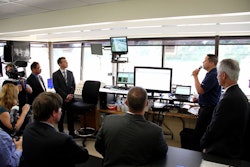Building airplanes is a complex task that includes a wide variety of materials, jobs, tasks, and responsibilities. An airplane manufacturer’s job isn’t done when the final product rolls out of the hangar either. Before the airplane can even be delivered to the customer it has to be thoroughly tested both on the ground and in flight by the manufacturer. All of the avionics, engines, hydraulic, and critical systems must be operating like clockwork—or it’s back to the drawing board for more fixes and tweaks (then, more testing).
In most cases, there will be something that doesn’t operate properly. It’s just the law of averages when you’re talking about an aircraft that’s made up of over 2 million parts. Every aircraft is also assembled with different configurations—a fact that virtually ensures that the product will not always work on the first time. That’s why airplane acceptance testing exists in the first place; it gives aircraft manufacturers the opportunity to go through and remove all of the discrepancies in order to be able to deliver a perfect, final product.
During the final “airplane acceptance testing” process, manufacturers literally collect tons of data. Every time a discrepancy surfaces the issue is included in an incident report for the particular aircraft. Then, once the test flights and other exercises are completed, companies aggregate all of the collected data and review it thoroughly to figure out what is and isn’t working.
The reports, which can include many different sections and subsections, must then be filed away for future use. This helps manufacturers pinpoint recurring problems, for example, and come up with global solutions to those issues. In most cases, aircraft manufacturers use metadata to achieve this goal. To capture this data, the inspector conducting the test writes down all of the findings and creates an incident report that’s then tagged with various metadata. They tag the issue under a serial number, and notate the inspector’s name, the data, and the specific problem.
Also within the metadata are codes for specific parts such as landing gear, engine, and so forth. That entire set of information then goes into one or more systems for later use. And while this system can be effective for logging, storing, and retrieving structured data (serial number, code number, and/or tags), there is also a lot of valuable knowledge that lies in the related unstructured data. The general notes that an inspector writes down, or his or her opinion on the possible solutions to the issue, aren’t always easy to locate and retrieve, but they are valuable.
The good news is that there is a way to make an organization’s unstructured data easier to find, thereby shortening the amount of time needed to perform aircraft acceptance testing. This is particularly important for manufacturers that don’t get to recognize revenue until they actually deliver the aircraft—an activity that can’t take place until all of the testing is completed to satisfaction. When the latter occurs at a faster rate, manufacturers gain the value of earlier revenue recognition. In addition, the time it takes to test, troubleshoot, and engineer can eat up critical resources and lead to higher costs. Finally, with the right tools, notes, and incident reports at their fingertips, companies can fix problems sooner and better, thus improving quality. That’s quite a trio of benefits.
Aerospace Giant Leverages Collective Knowledge and Creativity to Power Innovation
One global aerospace company addressed its technical knowledge management challenges by implementing an enterprise software platform fusing ideation and problem-solving methodologies with access to corporate and external knowledge. The software automates and facilitates knowledge capture and reuse, enabling engineers and scientists to stimulate creative idea generation to drive breakthrough problem-solving.
With the platform in place, the aerospace company's scientists are empowered to leverage and build on the experience of their historic space exploration programs, which includes hundreds of thousands of documents such as materials, engine performance data, and ground support equipment inventory.
What's more, the company's scientists are able to collaboratively define problem and opportunity areas in a common language and use a structured process for inventive problem-solving and concept-generation—critical in aerospace platforms and systems that often comprise interacting subsystems that independently and collectively must satisfy a complex set of performance requirements.
To date, the company has used the software in dozens of workshops, generating ideas and solutions for numerous products and projects, including two high profile rocket engine initiatives. These engines are complex systems comprised of several major components, each of which is made up of countless sub-components. Using their new platform, the manufacturer's scientists and product teams generated more ideas and translated these ideas into products.
In addition to fueling the product pipeline with competitively differentiated products, the platform has delivered significant cost savings to the company. Within one year of implementing its knowledge management program, with the new software as the backbone, the company reported an impressive 10-fold return on investment through cost savings efforts. The program continues to pay back huge dividends while the manufacturer regularly benchmarks and refocuses its knowledge management program to ensure its future success.



















